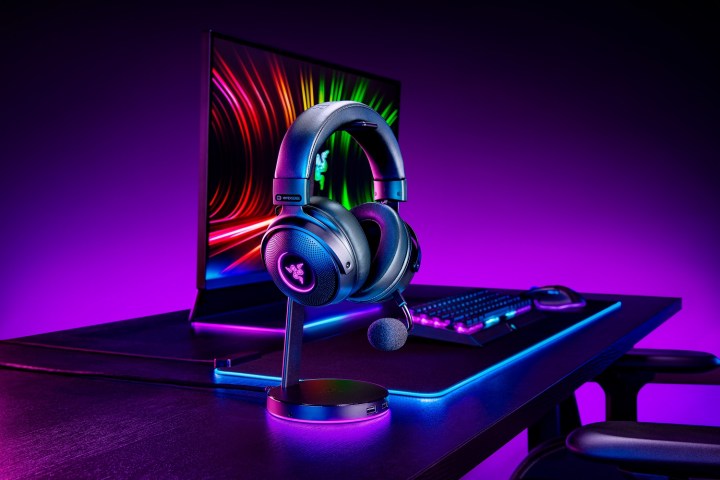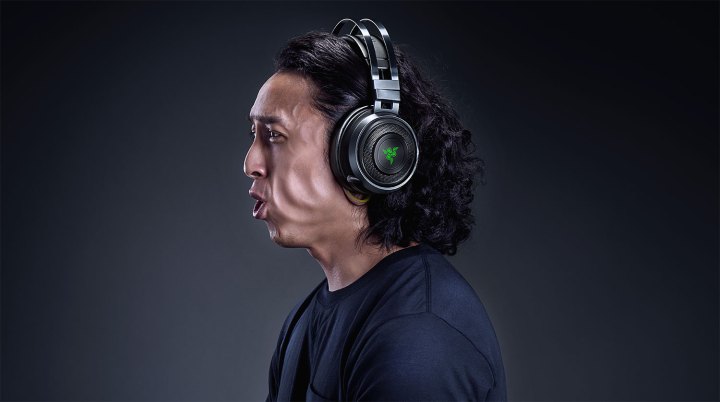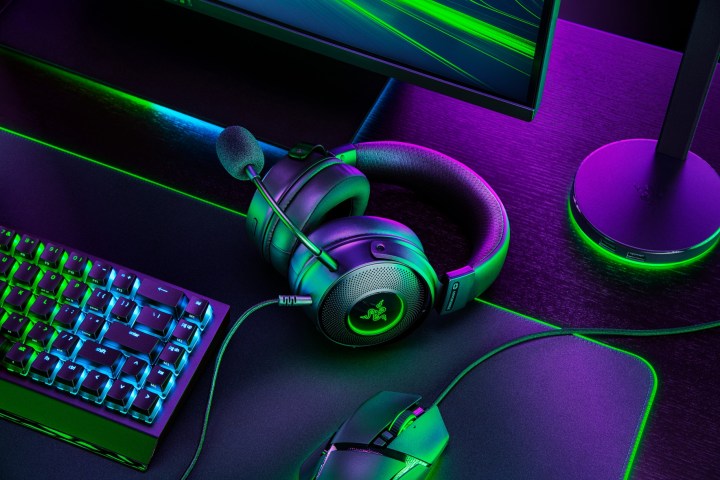I never thought vibrating headphones would be a good idea until I tried the recently-released Razer Kraken V3 HyperSense headset. It’s a jarring concept at first — why would I want my headset to vibrate? But after spending some time with Razer’s HyperSense technology, I’m a believer that haptic feedback will show up in the best gaming headsets in the future.
But, the concept requires belief. Although haptics have a chance to elevate gaming, watching movies, and listening to music, the options available today aren’t great — Kraken V3 HyperSense included. Here’s why haptics feedback headphones are a great idea and what companies need to do to make the tech better.
Why haptic feedback headphones make perfect sense

Vibrating headphones might seem like a gimmick, but they make perfect sense. Sound is vibration, physical vibration is just sound that you don’t hear, and all the places where you’d want haptic feedback are the same places you’d hear low frequencies — in particular low bass parts. If you’ve ever used a pair of headphones with a “bass boost” feature, you already know this. Boosting the bass also vibrates the headphones.
If our headphone reviews are a mainstay for you, you can skip past this first section. For everyone else, allow me to indulge myself. HyperSense operates within a range of frequencies — based on a Razer chart, somewhere around 20Hz to 180Hz. It’s no secret that humans hear sound in the range of 20Hz to 20kHz, with the high frequencies generally slipping from overexposure to loud noise or age.
High frequencies are clear; either you hear a high pitch or you don’t. Low frequencies are vague. As the frequency goes lower, the sound starts to morph from sound into feeling. Sound is just vibration, and after a certain point, you stop hearing, and you start feeling.
HyperSense makes the low-end sound bigger. You don’t add a subwoofer to an audio system to hear low frequencies — you add one to feel low frequencies. HyperSense does the same thing in headphones. The problem is that, unlike a subwoofer, HyperSense isn’t producing a range of frequencies. It’s reacting to them, which can ultimately lead to a disjointed experience. That’s exactly how haptic feedback headphones feel today.
Expectation versus reality

The Razer Kraken V3 HyperSense headset sells you on expectations. Immediately after hearing about haptic feedback headphones, I conjured up images of bombastic bass blasts in blockbuster trailers, sounds of scraping shrapnel in AAA war video games, and the thump of a thick bass guitar grooving heavy on a beat.
For brief moments while using the headset, I experienced all of those scenarios — just not consistently. There’s an inherent flaw with the design of HyperSense. It works based on a threshold. Think about haptic feedback in a controller; developers choose when to trigger the haptics, what sounds or images it’s reacting to and what vibration it’s trying to mimic.
Massive bass blasts send a ripple throughout the headset, but so does a deep voice.
That’s not what HyperSense does. It’s taking the audio that it’s fed and spitting out feedback based on, from my testing, a narrow range of low-end frequencies. Massive bass blasts send a ripple throughout the headset, but so does a deep voice. That leads to a strange disconnect where HyperSense draws you into an experience before pulling you immediately out of it.
After watching the Dune trailer and a compilation of the trailers from the latest PlayStation showcase, I was ready to shout from the rooftops that HyperSense is the way to experience media with headphones. After playing through some of Guardians of the Galaxy and hearing Star Lord’s voice reverberate through what sounded like broken bass port, though, I have a different impression.
There’s a strange balancing act with HyperSense between what is and what could be. Although it would take an army, individual game and movie support could elevate HyperSense from an amusing shoo-in to an essential feature on any pair of over-ear headphones.
Preparing for a headache

One of the problems with HyperSense is the intensity. Razer thankfully included a button on the Kraken V3 HyperSense that allows you to adjust the intensity on the fly, but it has four settings: low, medium, high, or off. Even in the Synapse software, you can’t adjust the intensity manually.
The feedback would bob back and forth between being too much and not enough. At its best, the vibration was a nice reassurance that immersed me in a game or movie. At its worst, HyperSense would rock the headset halfway off my ears, produce no feedback at all, or give me a massive headache.
For haptic feedback headphones to work, you need to be able to adjust the vibration and the sound independently on the fly. It’s a balancing act, and even after dozens of hours of using the Kraken V3 HyperSense, I would reach for a feedback intensity dial that wasn’t there.
This technology needs a way to filter out the junk frequencies.
Independent, granular controls are essential because everything reacts a little differently to the haptic feedback. Most well-produced music with a consistent low-end worked well with the Kraken V3 HyperSense, but video games and movies were all over the place. HyperSense makes a bad audio mix apparent immediately.
Beyond fine control over the intensity of the vibration, this technology needs a way to filter out the junk. As mentioned, HyperSense operates within a range of frequencies, topping out somewhere around 200Hz.
There are a lot of junk frequencies between 100Hz and 200Hz, and I suspect the disjointed feeling of HyperSense is largely due to this range. Here, bass starts to sound like cardboard. It’s not low enough to feel like a sub frequency, but not high enough to venture into the midrange. Filtering would not only lead to more consistent haptics but also allow users to tune the headset for fewer headaches.
Not quite there yet

HyperSense is just a concept. Although Razer now sells two headsets with the feature, it’s not ready for prime time yet. If anything, it’s a proof of concept. It still needs independent, granular controls, as well as dedicated integrations in games and movies.
Still, it’s more than a gimmick. Razer hasn’t been shy about gimmick-y concepts — just look at the ridiculous Zephyr face mask — but HyperSense is different. After using it, I’m convinced that haptic feedback headphones are a concept that not nearly enough companies are exploring. Corsair has the HS60S with haptic feedback, but that’s it.
Hopefully, more companies will recognize it as a legit feature and not just a gimmick. Maybe then the technology will get some of the improvements it desperately needs.




